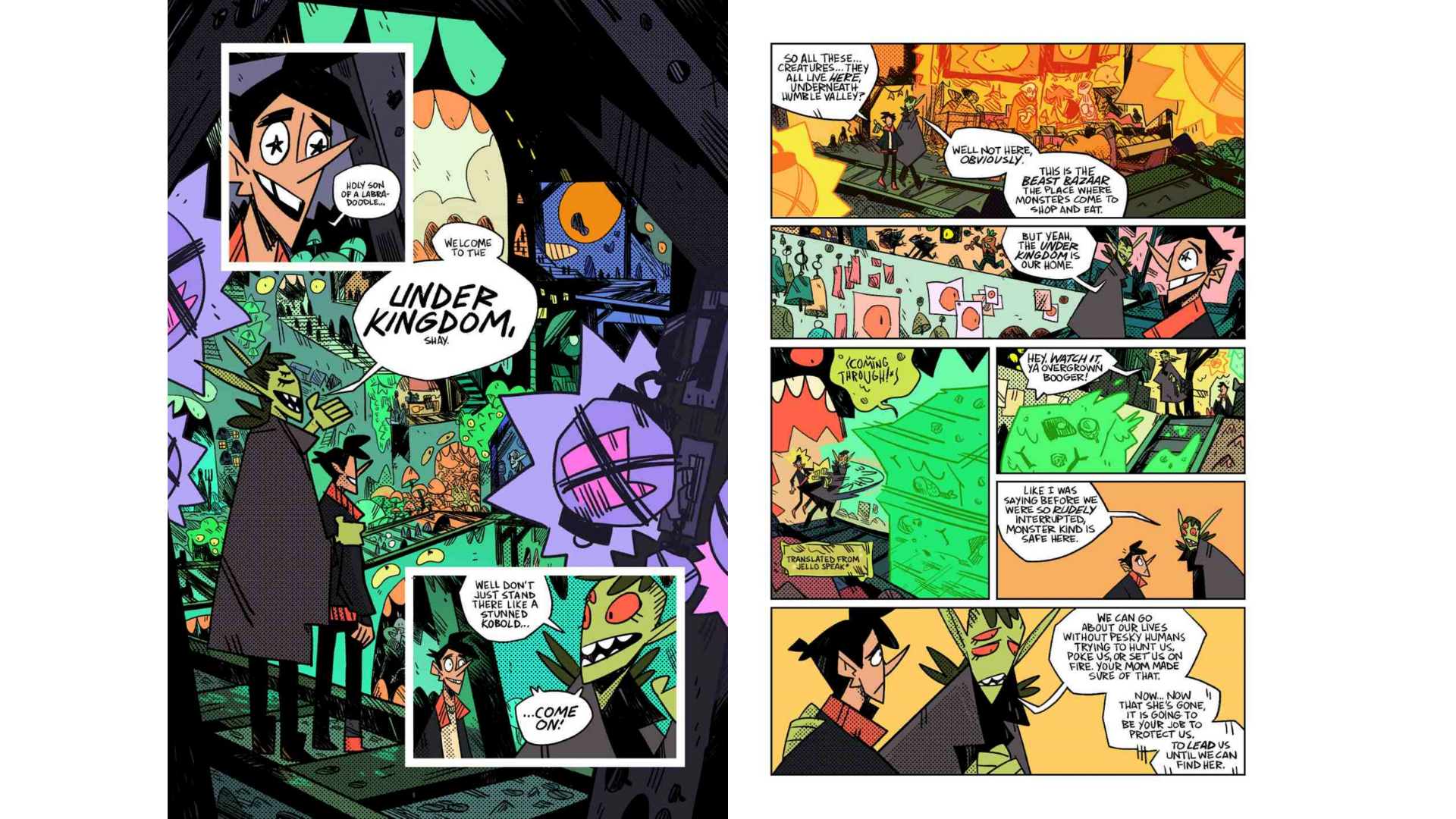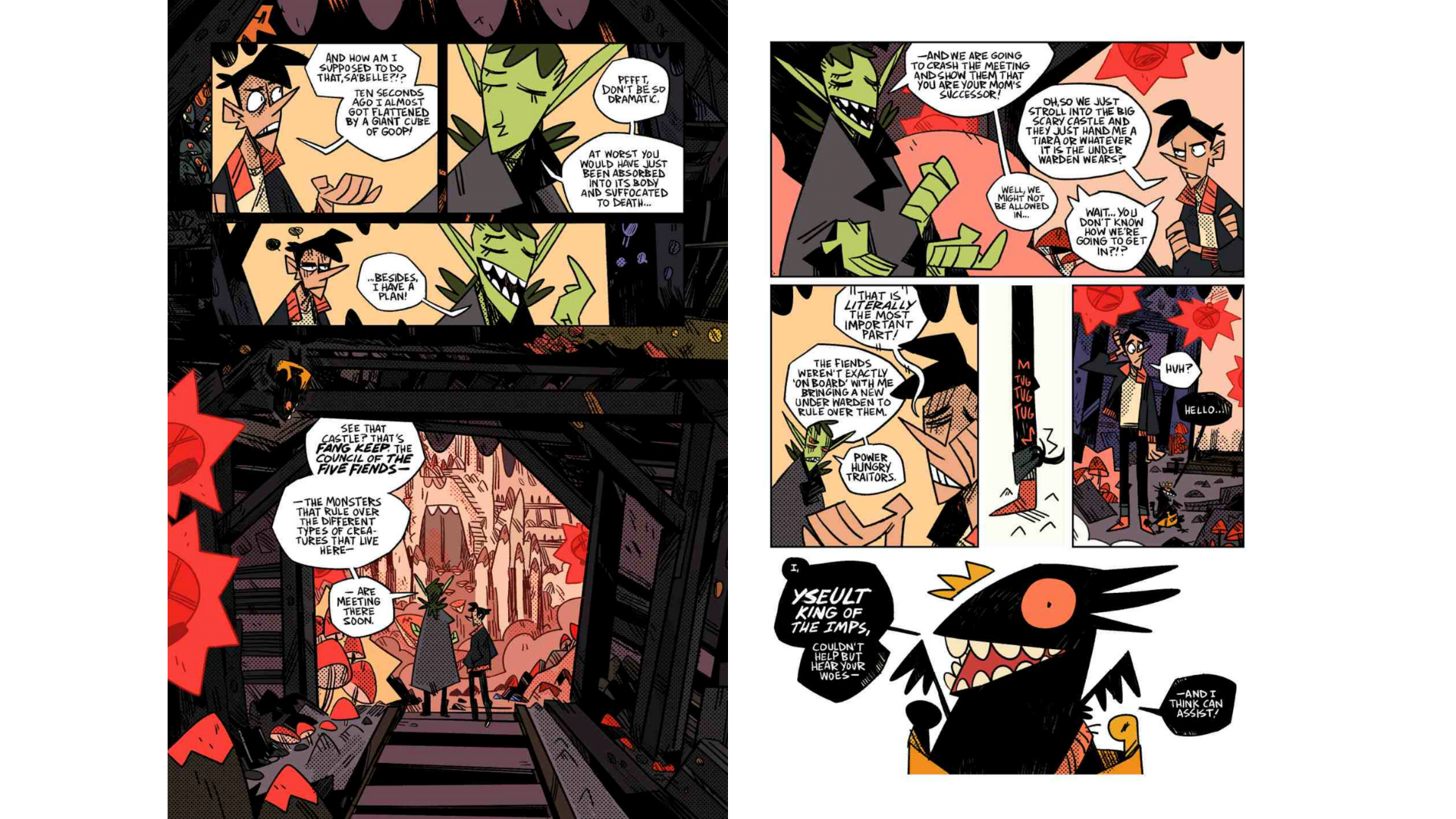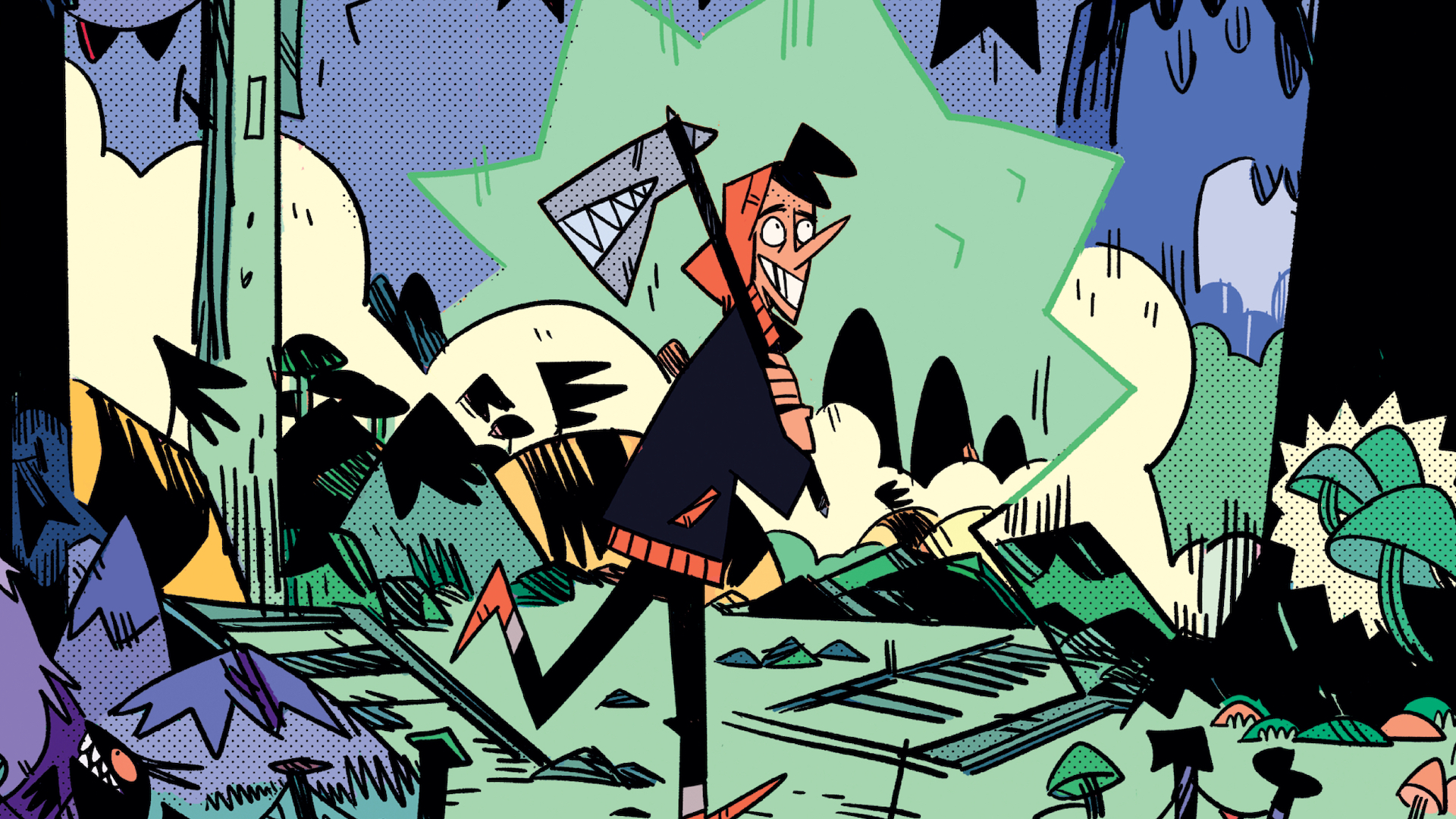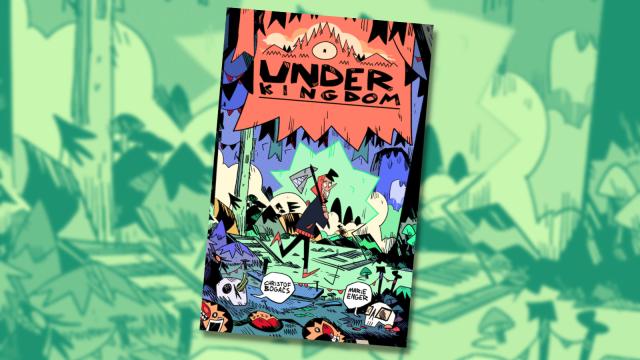One day, you’re just a normal teenage kid and then the next day you find out you’re the protector of a secret underground kingdom of fantasy monsters. Very normal stuff! That is Under Kingdom in a nutshell, a new fantasy graphic novel written by Christof Bogacs with art by Marie Enger.
The comic follows Shay, an average teenager who is thrust into a subterranean world of fantastical creatures after his mother mysteriously disappears. He learns that he comes from a long line of Under Wardens, who are sworn protectors of monster-kind and their home, the Under Kingdom, it’s now up to him to keep the peace between all these different monster factions. Also, his aunt is a changeling. Like I said before, normal stuff.
It’s a really fun book, chock full of heart, incredibly goofy gags and fresh takes on fantasy beasts, all of which are amplified by the punky, high-energy cartooning of Enger – think Adventure Time fed through a distortion pedal.
I’ve been following Bogacs’ work for a while now – he’s Sydney-based and submitted a short story to the first comic anthology I published back in 2018 – so it’s exciting to see a local writer being picked up by a big-name publisher like Dark Horse Comics. Ahead of its release, we spoke with him about the creation of Under Kingdom, what it’s like to write with an all-ages audience instead of an adult one, and how he and Enger played around with classic fantasy tropes to create something unique.

I know you’ve done a few short comics in the past but this is your first major graphic novel release. How are you feeling now that it’s done?
Christof: I joke that, particularly as a writer, comics are like 90 per cent waiting. So Marie and I started working on Under Kingdom in 2019, 2018. I think 2019 was when it got picked up and we signed the contract, so we were working for about a year before that. We’d started talking about it then, so it’s very surreal to have it out. It’s very interesting because, obviously, for me and Marie this feels like old work, but for the audience, it’s brand new. This is the first time that they’re really getting exposed to my work. So, it’s very weird and there’s a kind of disconnect, but ultimately really exciting.
Can you tell me how you came up with the concept of Under Kingdom? What were the biggest inspirations for the story?
Christof: So the video game Dungeon Keeper was basically the starting point. Which is funny, because I never played it as a kid, but my friends had it. And for some reason, because I was raised as a conservative Christian kid, it scared me.
And then as an adult, I went back to it and it was like, “Oh, this is a really interesting concept for a game.” But what was interesting to me about something like Dungeon Keeper is that there’s not really any, at least to my knowledge, huge mythology behind it, or cohesive mythology.
So that’s kind of what I wanted to do, is think about a Dungeons & Dragons dungeon crawler or whatever, and how does this world actually work? Because obviously, you know, these worlds exist for the player, in the case of Dungeon Keeper to plan or if you’re a D&D character to go through and kill shit. But how would it actually work? So that’s kind of where it started.
And initially, it was going to be an adult book. But I found myself being written into a corner in terms of, well, if it’s an adult book I kind of have to deal with the morality of killing and it’s going to get real dark, real quick. It kind of became Breaking Bad with monsters, which I didn’t want to do.
So it wasn’t until Marie approached me in 2018 about the fact that a book publisher had asked them to send through a middle-grade pitch. I threw Under Kingdom their way.
We’re both big fans of Dreamworks’ Trollhunters. So we were talking about what we liked about the show and the creative decisions we didn’t quite agree with – “We liked that it did this, but if we did, we’d do it this way.” And then Under Kingdom came out of that, which was like, “Oh, I’ve got this idea. What if we did that, to do our own version of Trollhunters, and make the changes and or the zigs and zags that we want to do?”
And then reworking it as a kids’ comic, was really, really freeing. You could make it silly and fun, and I think it made it a lot easier to deal with these kinds of monsters through the lens of a kids’ comic. Because kids are just so much more open and accepting. I had all these other directions that I could go and play in.

I read Jeff Tweedy’s How to Write One Song recently and he talks about how, if you’re an adult trying to sit down and write, you struggle so hard because your brain overthinks everything. Whereas if it’s a kid, they’re way more willing to play around with things. Especially with something like fantasy where I feel like a lot of adult fantasy leans really heavy on lore and canon. You have a little bit of that in this with things like the Council of the Five Fiends, but you don’t dwell on it too much. You give it space for the reader to fill in what they think this world is.
Christof: It’s funny because I really like writing fantasy, but I’ve always struggled, particularly in the novel space. When people talk about fantasy or high fantasy, a lot of the time it feels like they come at it from a world-building thing. I know people who have played in that space and for them, it’s like, “Oh, I’ve got this world.” And that’s where it starts.
But for me, that’s never where it starts. It always starts with, here’s the story, here’s the character, here’s the change they go through and the world is kind of built around that. So in Under Kingdom, the story and Shay existed and the world was built and filled out around them.
Which is probably why it feels sort of dynamic. We only introduce you to the monsters and the concepts that are needed to get this part of the story. And if we do more, it’ll be the same thing. We’ll introduce you to stuff you need to know for that instalment.
And then my other approach to fantasy is that I like using what already exists but playing with it. So this is where Marie’s art was really great – the dwarves are a great example. There were some aspects of fantasy dwarves that we wanted to work with, like that they live underground, they’re big into mining, they’re very sort of honour driven, and they’re tough.
But then Marie brought this very primordial caveman element to it, which I love. We discussed the idea that, well, if they’re underground, let’s make it so they’re adapted to living underground. They can’t really handle the surface so they can’t handle light, and they don’t have eyes because they don’t need them anymore, and things like that. Let’s take some of the core ideas of this fantasy race, but play with them to make it feel weirder and more inhuman, which I love to do.
That’s something I wanted to ask you about. I like how you remix all these very classic fantasy creatures. And I think a lot of that comes from Marie’s art as well, especially with things like Lemon the dragon. That’s such a fun design, just a big loopy snake.
Christof: I can’t stress enough that Lemon was 100% Marie. So Marie just sent me a drawing and was like, “Oh, this is Lemon. He’s got wings on his butt.” And that was, from memory the most they told me about Lemon. And I was like, “Roger that, I got it.” And that was kind of the entire discussion we had about Lemon.
From that drawing, I knew Lemon’s vibe. And Marie’s been drawing Lemon for years. So if you go to a dingy bar in St. Louis, it’s quite likely that you might see a Lemon scrawled on a table. Lemon has been a figure in Marie’s life for ages, and I was lucky enough to be able to work him into Under Kingdom.
We would grab whatever we thought was cool and fun, without any remorse. That was both from Marie’s bestiary because they’ve been drawing monsters their whole life, and traditional fantasy stuff as well.
With Marie, how did your collaboration with them start? Was the book always written with them in mind, or did they come on board after you had a general idea of what Under Kingdom was?
Christof: So when they came on board, Under Kingdom was just a concept. It didn’t really get life as an all-ages thing until they came on board.
I met them at Emerald City [Comic Con] in 2018. They did a really cool zine called Punks Win, where they illustrated a bunch of punk songs. They illustrated “Cheap Beer” by FIDLAR and then “Pine Point” by PUP.
And I’m a big fan of both of those bands, but I didn’t really know anyone else who was into them. So we instantly bonded over that. Particularly, there’s something about punk music where it’s like, if someone likes punk music, you probably have at least similar ethics. Because the DIY ethic and the politics are so baked into it that it’s unlikely that people who like punk music are going to meet and not have some common ground.
So they invited me out to join them and a group of people for dinner, and we’ve just been talking ever since.
Something I really liked about Marie’s panels is how they’re chock full of fun little details and visual gags, but it never feels overwhelming. What was the creative process like for the book? I know Marie is US-based and you’re down here, so how close were you working together, building the world of Under Kingdom?
Christof: Very close, I would say. I think a lot of comic writers write fairly open-ended scripts. And the idea is like, I’m writing the IKEA instructions to build the furniture, but what I’m writing is not the furniture itself. A great example is the scene where Shay and Sa’Belle are in the basement with all of [Shay’s] mum’s regrettable infomercial purchases. I gave Marie a few ideas and then they just added a bunch of stuff that they thought was funny, like Sand Trash.
Usually, for background gags, I would try and have a few specific ideas, but Marie could just add whatever they wanted. I’m a big Simpsons guy, and one of my favourite things about The Simpsons is that you can freeze it on just about any frame and if there’s like a sign or label or something, it’s going to have a joke on it. I think Marie and I both vibe on that idea – of value for the reader. Like you’re rewarded for spending some more time on this panel.

With your writing, what was it like trying to find the right balance between the more humane side of the story and the more fantastical elements? One of my favourite sequences is the montage of Shay training and him hanging out with Ed. It’s like really quick and wordless, but it does a really good job of establishing his growing relationship with them, while also showing Shay trying to get better as this heralded warrior.
Christof: I mean, I love a montage. And particularly in comics, I think they work effectively well. More so than films in some ways, I think. With the fantasy stuff and balancing that kind of thing is a little bit like my approach to balancing the comedy.
My fiance, who comes from a stand-up and poetry background, gave me the really good tip that you need to establish, particularly with comedy, what is novel and what is weird. Because if everything is weird and bizarre and out there, then nothing is. So with any fantasy thing I introduced, I wanted to be very clear on the rules.
And also, for the most part, you want to keep the beats. Like the core beats, they might involve a fantasy whodunit or an item or whatever, but the actual beat has always got to be grounded in a real human emotion.
Obviously, there’s a fantastical premise: “Shay finds out that his mum ran the Under Kingdom and led these monsters.” That’s a fantastical element, the human element is living in the shadow of your parent. And that’s a very grounded emotion. So for me, that’s where it came from. What do we need to make the real emotional and grounded beats work? Everything kind of moves around that, both the comedy and also the fantastical elements.
I really liked how you built up Shay. There’s the fantasy cliche of “The Chosen One” who needs to take up the sword and learn they’re a great warrior, but you subvert that idea. Shay doesn’t take a route of physical action, he’s more about solving a problem without drawing his sword in the first place. When you were writing it, was that a big concept that you were playing with from the beginning?
Christof: 100%. We’ve consumed a lot of the same stuff growing up, so I assume you can probably relate to this, but a lot of media aimed at boys is all combat-focused. I look at what I watched, Dragon Ball, Beyblade, Pokémon – and not that Pokémon is specifically for boys – but they all kind of have a battle or a combat element.
Every plotline is almost always about the character coming up against a new opponent, the new opponent is too strong, so they dip right away to get stronger themselves and dominate that new opponent. Dragon Ball is a really good example of that, and so is Pokémon. But it’s the same beat again and again and again.
So for me and Marie, we were like, well, we want to create something that doesn’t do that. Because, for us, that was an interesting angle. How do we avoid doing that and show kids alternative forms of conflict resolution? There’s nothing wrong with media that involves conflict, or at least I don’t think there’s anything wrong with that, but the issue is that it’s really the only, or the majority of media, that kids are getting.
It’s getting better now and changing, but that’s kind of the idea. Let’s vary kids’ media diet and make them aware that there are other ways to deal with conflict. And I think, particularly in the very complex times we’re living in now, diplomacy and empathy and figuring out what makes your rival or opponent tick, and being able to appeal to that is more important than ever.
How did you find writing all-ages work compared to writing for an older audience?
Christof: It’s interesting because I think a lot of people view writing kids’ media – and I certainly did initially – in terms of, I can’t swear, I can’t do blood, I can’t do this, I can’t do that. A lot of can’t dos. For me, the big click, and when I found my voice in that space was, “Oh, actually, here’s all the things I can do.” Once I moved Under Kingdom from an adult story to a kids’ story it just opened it up, because suddenly, I didn’t have to do the things adults expect in a book.
Kids are so much more open and accepting. So I think that’s what Under Kingdom tries to lean into. We really quickly introduce monsters and a whole bunch of different things knowing that kids will just roll with the punches. With adults, I think you probably would have to spend a little bit more time explaining all the rules, all of that kind of stuff. Because I feel like adults often really want to poke holes in stuff. It’s just the way our minds tend to go.
I started watching Severence last night, and pretty much the entire first episode just teaches you the mechanics of the sci-fi technology they’re playing with. In Under Kingdom, we kind of do that in one page, and we’re done, so we can move on and get on with the story. I just find it incredibly empowering and freeing.

We’ve seen a big uptick in the popularity of young adult graphic novels over the last decade. Why do you think that is?
Christof: I think a big part of it is accessibility. I remember when I first got into comics, I saw the X-Men movies and I wanted to find out more about the X-Men. And I spent a couple of hours googling X-Men comics and I was lucky that at the time, the comic I found was one I clicked with. If I hadn’t, I probably wouldn’t have gotten into comics.
The fact that graphic novels are now moving to book publishers and they’re in regular bookstores, so there’s less of that barrier. And the fact that there’s the shift towards graphic novels, as opposed to floppies. I get that a lot of people love floppies and have a lot of affection for them, but it’s a tricky format. It’s a specialist niche format. Comic shops, particularly in Australia, they’re niche shops that not everyone has access to.
I think people inherently like graphic novels and graphic storytelling. I mean, look at the popularity of Tintin and Asterix. They’re not even seen as graphic novels, they’re classic kids’ literature.
So I think if you have it accessible, people will find it. And I think in the last 10 years, the book publishers have cottoned on and are like, “Oh, there’s actually a viable market.” That’s helped accelerate everything. And then on the flip side, now you have direct market publishers like DC and Marvel, either working with book publishers or doing their own YA middle-grade stuff that is aimed to be in bookstores.
On other comic trends, I feel like Australian cartoonists and comic makers are having a bit of a moment overseas. We’ve seen a lot of locally-made big graphic novels released in the last couple of years. What advice would you have for any local comic makers who are looking to break into the industry?
Christof: I have a lot of thoughts on this. One thing I’ll say is that it’s getting better but the Australian market is really fragmented in a lot of ways, in terms of, individual scenes across the country.
There’s the Melbourne scene and then the Sydney scene and the Perth scene. They’re all kind of little scenes, and we’re trying to get better at it, but we haven’t always talked to each other. And I’m just as guilty of that. Currently, there are a bunch of people I see all trying to push a coming together and consolidating the comics talent.
And certainly, as an Australian creator working in the US market, I try my best to reach out and keep in contact with other Australians working in the US market.
So that would be my first piece of advice is if you’re interested, reach out to Australian creators, specifically if you want to be in the US market. Obviously, there’s a lot of great indie stuff and Kickstarter stuff here. But if you want to learn how to get traction with US publishers then talk to people who are actually doing that. A lot of people have a lot of advice that isn’t necessarily grounded in practice.
And then the second thing I would say is to get to a US convention as quickly as you can. There are a lot of different kinds of thoughts on this, and there are certainly people who say you don’t need to do it, but I personally think, at the very least, it makes it a lot easier.
A lot of the time, comics editors are getting cold-called and pitched so many times, so actually meeting them in person and saying who you are helps. And if you come from Australia, let them know, because it’s like, “Oh, this person’s dedicated, they jumped on a 20-hour flight.”
You mentioned before that you met Marie at the Emerald City Comic Con. So if you don’t have that face-to-face, then Under Kingdom probably doesn’t look or exist as it currently is.
Christof: I think Under Kingdom exists solely because of Emerald City, right? I met Marie there one year, and then the following year, we met our editor at Dark Horse and pitched him the book that became Under Kingdom. That book doesn’t exist without that specific US con.
I know you’ve been writing another series, which has been coming out in single issues, called Meat4Burgers. I guess the easiest way to describe it is that it’s about the existential horror of working in fast food hospo. Apart from that, what’s next for you after Under Kingdom?
Christof: I’ve got a book coming out from HarperCollins in 2024, Earth to Chris Cleevy. It’s a middle-grade graphic novel that deals with childhood OCD. It’s about a 10-year-old kid who’s convinced that his mum’s new boyfriend is an alien. It’s ’90s sci-fi mixed with a real-world exploration of OCD. And then outside of that, I’m just in the process of signing the contract for my first adult project, which I’m really excited about. That shares a lot of DNA with Under Kingdom in the sense that it’s fantasy, and we’ll be playing with fantasy tropes. I’m really excited for when I can talk about that a bit more.
Under Kingdom will be available in comic shops from 19 April and in Australian bookstores from June 6.
Here’s where you can preorder a copy: Amazon Australia ($22.49) | Angus & Robertson ($28.50) | Booktopia ($28.50)

Leave a Reply